A partial muster list of Quonset Point musicians
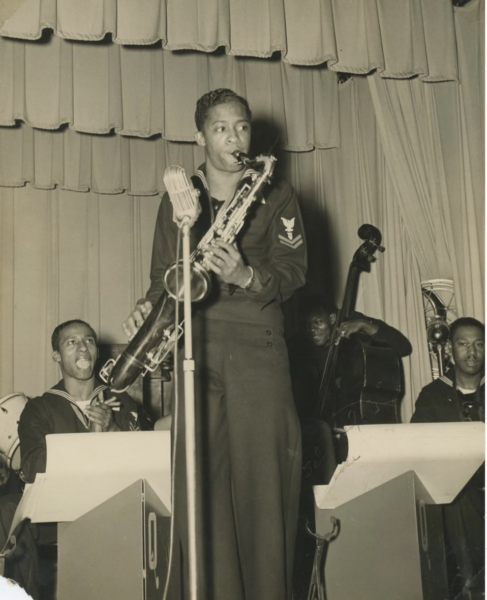
Chuck Clarke, at left, encourages his little brother Babe Clarke as he solos on sax in Chicago, prior to Quonset Point service. Southern Music Research Center, Birmingham..
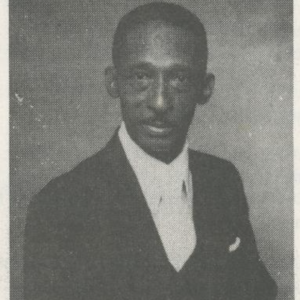
Portrait from funeral program. Southern Regional Music Center.
Clarke, Charles “Chuck” (1920-1990) saxophone
From Birmingham, Alabama, he graduated from A.H. Parker High School, attended Miles College, and graduated with honors from Morehouse College. He married Juanita Waiters in August 1946; they had 5 children.
He played with Fess Whatley’s band prior to the war and also with Cootie Williams’ big band, and is a member of the Birmingham Jazz Hall of Fame.
Clarke, Arthur F. “Babe” (?? – 1992) saxophone
Babe Clarke, the youngest of the talented Clarke siblings in Birmingham, also studied with Whatley. Whether he and his brother remained for the duration at Quonset is not known. After the war, he performed and recorded–often with the Babe Clarke horn section–with Ella Fitzgerald, Benny Goodman, Johnny Hodges, Lionel Hampton, Ray Charles, Eartha Kitt, Harry Belafonte, Sam Cooke, Aretha Franklin, Dionne Warwick, Stevie Wonder, and Quincy Jones, and the Leon Thomas Blues Band. He performed on movie and TV soundtracks The Wiz, School Daze, Mo’ Better Blues, The Cosby Show and in the pits of several Broadway shows.
Cloud, Hamilton S.
Dr. Hamilton S. Cloud, who was honored in 2003 as one of the pioneering bandsmen of the Great Lakes Experience, traveled from his Birmingham, Alabama home to Atlanta to enlist when he heard the Navy was recruiting African-American musicians. Upon hearing that Cloud played E-flat clarinet and having none on hand, his recruiter said they would have to find one to borrow: “We went to several musical instrument stores to borrow one,” he said. “The recruiter then asked if I could read music. When I said yes, he looked in his files and pulled out several military band selections and asked if I would hum the music for him. Having played in a marching band for four years in high school and four years in elementary school, I could have easily hummed from memory any selection that he presented.” So impressed with him was the interviewer that the two of them drove back to Birmingham to find more musicians who’d been trained by Cloud’s teacher, the legendary Fess Whatley. Several more Birmingham musicians subsequently joined the Navy as musicians.
When Cloud’s band left for Quonset Point, it was the first band to graduate training at Great Lakes. He recalls other bandsmen at Quonset Point as being from Birmingham, Tuskegee Institute, St. Louis, New York, and Philadelphia.
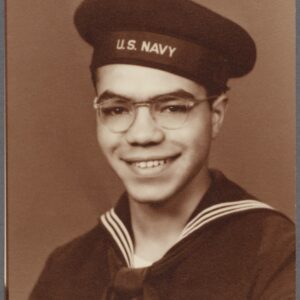
Ulysses Kay’s official US Navy portrait. Courtesy of Columbia University , Archival Collections, Ulysses Kay Papers.
Kay, Ulysses (1917-1995)
Born in Tucson, Arizona, Jan 7, 1917 & died in Englewood, New Jersey, May 20, 1995. Kay, the nephew of cornettist and bandleader Joe ‘King’ Oliver, studied piano, violin and saxophone before he enrolled at the University of Arizona. He completed his MA in composition at the Eastman School, where he studied with Bernard Rogers and Howard Hanson and composition with Paul Hindemith at the Berkshire Music Center and Yale University.
He was already an established composer by the time he joined the Navy, in which he served as Mus2c from 1942-45, training at Great Lakes before being posted to Quonset Point, where he was in both the marching band and dance orchestra. He continued composing while in the Navy: the New York Philharmonic performed his “Of New Horizons” at an outdoor concert in 1944, and his “Suite for Orchestra, 1945” won a prize from the fledgling BMI music-licensing organization. In 1947, Leonard Bernstein conducted the New York Philharmonic in the premiere of Kay’s “Short Overture.”
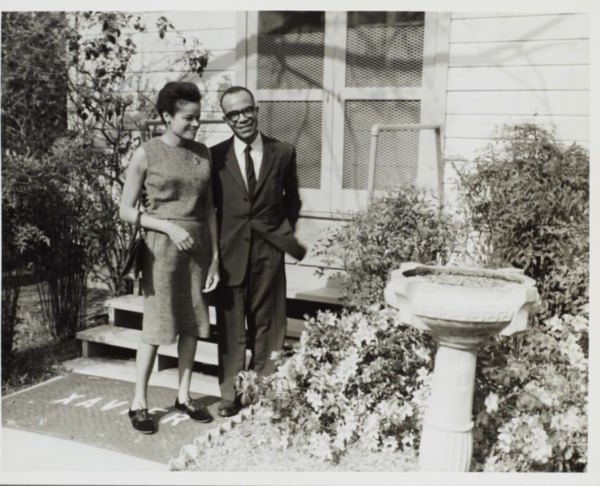
Ulysses Kay & wife, Barbara (1925-1997). Undated photo. Ulysses Kay Papers, Archival Collections, Columbia University. Barbara Kay was active in Civil Rights protests.
• • •
Quonset Point NAS
Quonset Point was chosen by Congress as the U.S.’s East coast base on June 7, 1938. In 1940, Congress approved $24,204,000 for the construction of Quonset Point NAS, which had been authorized in 1938. After “necessary changes were made to the landscape,” it opened in 1941. the construction was finished two years ahead of schedule in 1941, and included the 1748-acre Naval Construction Training Center and was the largest naval station in Rhode Island.
During the war, the station trained and shipped land-based and carrier-based anti-submarine squadrons, essential in fighting U-boats, and it was home to aviation squadrons, including the land-based patrol squadron P-2 Neptune and carrier-based antisubmarine and airborne early warning squadrons the S-2 Tracker, E-1 Tracer, and A-1 Skyraider. The deep water ports at the station also docked several ESSEX class air craft carriers.
Quonset’s records, which are housed in Rhode Island’s Archival and Manuscript Collection, may offer additional details about this band, but the Quonset records index does not include band references.
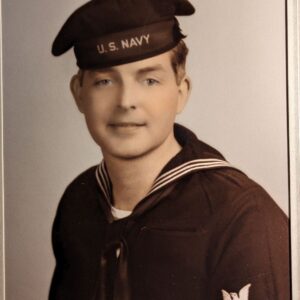
James Alexander Albright’s official U.S. Navy portrait, 1942
My father’s first Navy duty station was here, in 1942, and as a family en route from NC to Cape Cod, we drove about 1964 to its site; none of us but him were interested in anything about this detour. I can only imagine that he might have at least wanted to get out of our new Plymouth Fury, and that he might also have shared a memory or two.
• • •
Sources
Clarke, Charles. Funeral Rites. Program. Sixteenth Street Baptist Church, Birmingham, AL. 29 Oct. 1990. Southern Music Research Center, southernmusicresearch.org. 9 Dec. 2024.
“Dr. Hamilton S. Cloud.” in A Little Known Legacy: The Great Lakes Experience: A Salute to African-American Navy Bandsmen at the Great Lakes Naval Base 1942-45 [Chicago, IL] [Feb. 2003]. Collection of Carl Foster.
Wyatt, Lucius. “Kay, Ulysses.” Oxford American Studies Center.
–Alex Albright
December 9, 2024